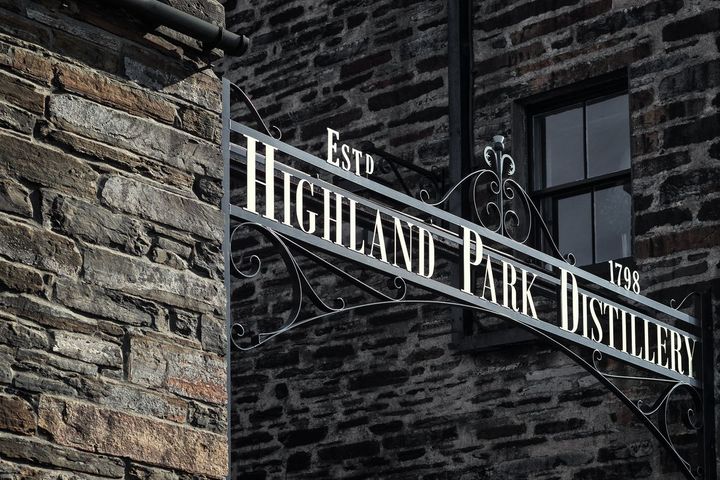
The Highland Park distillery, Scotland’s northernmost distillery
The Highland Park distillery has historically been considered Scotland’s northernmost distillery. That claim is subject to interpretation, however. Technically the northernmost distillery on mainland Scotland is the Old Pulteney distillery in Wick. That town is just twenty miles south of John O’Groats, the northernmost town of mainland Scotland. The Orkney Islands, which begin just ten miles off the coast of northern Scotland, host two distilleries: Scapa and Highland Park. Both distilleries are in Kirkwall, the principal town on the largest island, Mainland.
Highland Park is located about one-half mile north of the Scapa distillery, on the main road between Kirkwall, the capital of the Orkney islands, and the small town of Holm. The distillery is built on a hill overlooking the town, in an area called High Park, hence its name. A new distillery, however, the Shetland Distillery Company, recently opened on the site of a former RAF base at Saxa Vord in Unst – the northernmost of the inhabited Shetland Islands. The distillery has even a released the first ever “bottled in the Shetland islands,” Shetland Reel Single Malt Scotch Whisky, although the whisky itself was distilled and matured in Portsoy, on the Scottish mainland. Highland Park’s claim as the northernmost whisky distillery is still safe, but just barely.
The Orkney Islands have a long and colorful history. The Orkneys consist of 70 islands, of which 20 are inhabited. Mainland, the largest island at 202 square miles, houses about 75 percent of the islands’ 21,000 inhabitants. The islands are primarily made up of ancient old red sandstone – an assemblage of sedimentary rocks – found widely across the North Atlantic, of largely Devonian age.
These islands have been inhabited for about 8,500 years by various Mesolithic and Neolithic tribes, followed by the Picts. The islands contain the remains of the Neolithic village of Skara Brae, Europe’s best preserved Neolithic settlement and the oldest standing buildings in the United Kingdom. They date back to 3100 BC and predate both Stonehenge and the Egyptian pyramids. During its Norse period, especially from the 9th through the 12th centuries, the islands were a base for Viking raids throughout the British Isles and Ireland.
The archipelago was invaded and annexed by Norsemen from Norway in 875, and remained part of Norway until 1472. The Scottish Parliament seized the islands when Denmark defaulted on its promised dowry after Margaret of Denmark married James III. Technically, the islands have spent more time under Norwegian/Danish rule, 597 years, than they have spent under Scottish rule, 544 years.
The Orkneys were also the main naval anchorage for the Royal Navy during the 20th century. Scapa Flow is a sheltered, 120-square mile expanse of water created by the islands of Mainland, Graemsay, Burray, South Ronaldsay and Hoy. This protected water has a shallow sandy bottom between 100 and 200 feet deep, and forms one of the world’s superb natural harbors. At the end of World War I, the 74 ships of the German High Seas Fleet were scuttled here. Although many of the ships were eventually salvaged, the remaining shipwrecks make Scapa Flow a wreck diver’s dream site.
The Highland Park distillery was officially established in 1798, making it one of only a handful of Scottish distilleries founded in the 18th century. Like most Scottish distilleries, it’s likely that illicit distillation was taking place well before the official “founding” date. The excise taxmen didn’t arrive on the islands till the early 19th century. By then, the Orkneys had a well-deserved reputation as a center for illicit whisky distillation and smuggling.
The distillery was founded by Magnus “Mansie” Eunson, a larger than life character who, according to W.R. Mackintosh in Around the Orkney Peat-Fires (1898), “was a flescher (butcher) beadle (minor church official)” as well as an illicit distiller and smuggler. Eunson was famous for hiding his illicit whisky in his church. Alfred Barnard, Scotch whisky’s 19th century chronicler, recounted in his exhaustive history, Whisky Distilleries of the United Kingdom (1887), how on one occasion when the local excise men went to his church looking for his illicit whisky, he had the casks moved to a room in his home. Putting a coffin lid over the barrels and draping a white sheet over the lid, he proceeded to hold a funeral service. When the excise men, having found nothing in the church arrived at his house, one of the “mourners” explained that the “victim” had died from smallpox. The taxmen beat a hasty retreat and Eunson’s whisky stash was saved.
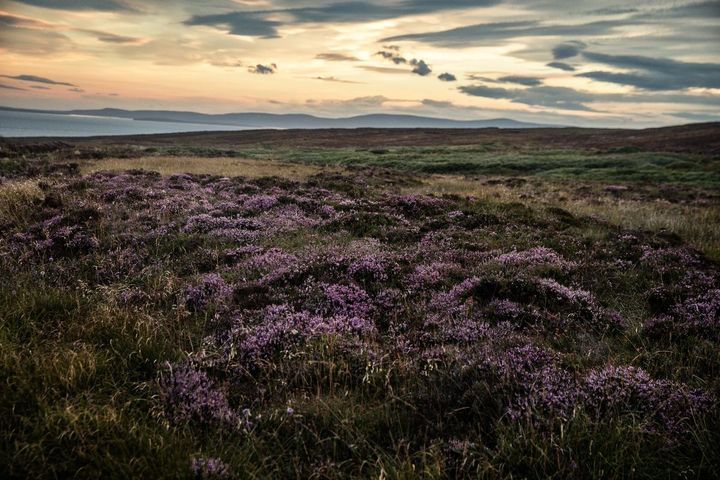
The heather covered peat bogs of Orkney
Interestingly, Eunson was eventually arrested for whisky smuggling and for operating an illicit distillery. He escaped prosecution by agreeing to sell the High Park estate and the distillery to the two arresting officers, John Robertson and his fellow taxman, Robert Pringle, and a group of investors in April 1813. Following the passage of the Excise Act in 1823, the distillery obtained a distilling license in 1826.
That same year, Robert Borwick assumed control of the distillery and expanded it. Many of the current buildings date back to this period. George Borwick, Robert’s oldest son, succeeded his father in 1840. Ownership, in 1869, eventually passed to Robert’s youngest son, James Borwick. James was a priest and had mixed feelings about owning and operating a distillery on the side. He subsequently sold the distillery, and a long succession of owners followed.
Stuart and Mackay purchased the distillery in 1876, just in time to take advantage of the first Scotch whisky boom. Highland Park was highly sought after by blenders, and was featured prominently in such well known blends as Chivas, Ballantine’s Dewars and Haig. The distillery was purchased, in 1895, by James Grant of the Glen Grant distillery. Grant doubled the number of stills from two to four. Highland Park has operated with four stills ever since.
Highland Distillers acquired Highland Park in 1937. Like many Scottish distillers, the distillery was closed during the Second World War. The area hosted Royal Navy forces, as well as a Royal Air Force Maritime Patrol unit. During the war, the washbacks were often used as a communal bath for servicemen in the area. For the first three-quarters of the 20th century, Highland’s Park production was geared exclusively to the whisky blenders. There were several independent bottlings of Highland Park during this period, but it was not until 1979, that the distillery began to bottle its own single malt expression as a 12 YO.
Highland Distillers (Macallan, Highland Park, The Famous Grouse) were in turn acquired by a 50-50 consortium consisting of Edrington Group and W. Grant & Sons (Glenfiddich, Balvenie and Kininvie) in 1999. Since then, under Edrington’s skillful marketing, Highland Park’s brand recognition, and incidentally its cost, have steadily risen.
There are quite a number of unique features about whisky production at Highland Park. First, the distillery is one of only seven distilleries that still do their own floor maltings (Laphroaig, Islay; Bowmore, Islay; Kilchoman, Islay; Highland Park, Orkney Islands; Springbank, Campbelltown; The Balvenie, Speyside; Benriach, Elgin, Speyside). None of these distilleries can malt enough barley to fill their needs, so all of them rely on commercial maltsters for the balance of their needs. Highland Park malts 20 percent of their barley needs. The barley used is the Concerto variety and is grown specifically for Highland Park. The rest of its malt is supplied by Simpson’s maltings in the Borders.
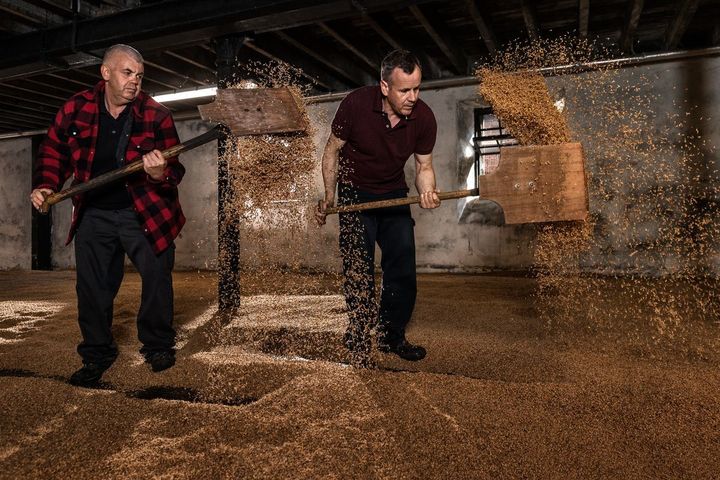
Floor maltings at the Highland Park distillery
The water used by the distillery comes from Cattie Maggie’s spring. The spring has been the traditional source of water for whisky distillation on the island. Unlike many of the water sources used in whisky production, however, this water is hard. Glenmorangie, Bunnahabhain, Craggenmore, Daftmill, Dalluaine, Glen Moray, Glenlochy, Scapa and Glenlivet all use hard water in their mashing operation.
The distillery has two kilns and utilizes peat from the Hobbister Moor, just down the road from the distiller. Orkney peat is very different from peat elsewhere in Scotland. Although the Orkneys are on the 59th parallel, roughly the same as Whitehorse, Yukon and St. Petersburg, Russia, the warming effects of the Gulf Stream gives it a temperate climate. The persistent winds, however, prevent the establishment of any significant tree cover. The result is that the peat on Orkney is made up primarily of partially decomposed heather. There is less moss in it and no woody remnants in Orkney peat, so the resulting peat reek has more dried floral elements and less of the pronounced medicinal and phenolic aromas than those found in Islay or the other western islands. The malt kilned at Highland Park is peated to a level of 20 parts per million phenol. It is then mixed with unpeated malt, which is brought in from the Scottish mainland. After distillation, peating levels probably drop to between six to eight ppm.
The peat from the Hobbister Moor is about 4,000 years old. The surface layer, which is only partly decomposed, is about 500 years old. The older layers, these have a brownie-like consistency, are several thousand years older. The older layers burn hotter, while the younger layers produce more copious amounts of smoke. The kilns themselves are ancient; the youngest is more than a century old. Kilning typically takes about 48 hours. During the first 18 hours, a combination of peat and dried heather are burned in the kiln at a temperature of 60 degrees Celsius, producing the peat reek in the malted barley. Approximately 1.5 tons of peat are consumed in each furnace during kilning. After 18 hours, the distillery switches to coke at a temperature of 65 degrees Celsius, to finish the drying process. The distillery estimates that at current levels of production, the Hobbister Moor has about a 300-year supply of peat.
Following kilning, once the barley is sufficiently cooled, it is ground in a Porteus mill. The standing joke among distillers is that Porteus mills were so reliable that once you acquired one you never needed to replace it. Even now, it’s not unusual to find used, decades old Porteus mills, being sold. Unfortunately, that meant that the company eventually went out of business. At Highland Park, the grind yields a mix of 70 percent grist, 20 percent husk and 10 percent flour. This is a typical grind for distillers that peat their malt.
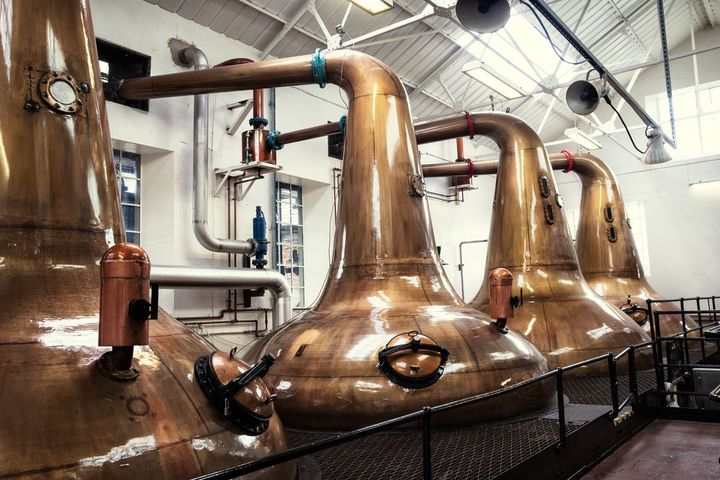
The four pot stills at the Highland Park distillery
The ground barley, 6.4 tons on average, is moved to a 11-ton capacity, semi-lauter mash tun and eventually the resulting wort, about 29,000 liters, is moved into one of 12 wooden washbacks (fermentation vessels). The vessels are made of “Oregon pine,” the local name for coastal Douglas fir from the northwestern United States. The distillery uses about 28 tons of barley a week. A mix of Kerry M and MX dry yeasts are used to start the 55-hour fermentation. The resulting wash comes in at about seven percent alcohol by volume (ABV). This is at the low end of the typical range. As a general rule, the lower the ABV in the wash, the more aromatic the resulting new make spirit. Low ABV washes require the removal of more water, concentrating the aromatic compounds in the wash.
The distillery has four stills, two 18,000-liter wash stills and two, 12,000-liter spirit stills. The stills are pear shaped, a style often referred to as Speyside stills, with wide conical necks that gradually narrow. The lyne arm that connects the neck to the condenser is at a 90-degree angle. Each wash still takes about one-half of a washback. They are charged to 80 percent. Each distillation cycle uses the contents of one washback and lasts approximately 5.5 hours. The wash stills produce a “low wine” with an ABV of around 26 percent. The distillate is then transferred to the spirit stills. These are charged to 75 percent. The heart cut runs for approximately 2 hours 40 minutes and is preceded by a foreshots run of 30 minutes. Casks are typically filled with new make spirit at 69.8% ABV. Casking strength depends on the intended use of the mature whisky. Whisky used in blended products is often casked at a slightly lower strength. This is higher than the industry average. Higher casking strength is more efficient as less barrels are needed. It also tends to extract more flavor compounds from the wood, although this is not always necessarily for the better. The distillery uses a variety of cask sizes: butts, puncheons and hogsheads, as well as ex-bourbon barrels. Highland Park has an annual capacity of 2.5 million liters of new make spirit, which equates to about four million bottles of Scotch whisky.
Approximately 90 percent of the new make spirit is matured in “sherry seasoned casks.” At Highland Park they use Oloroso sherry, a dry, dark, fortified wine with pronounced notes of nuts and dried fruit. Historically, the Scotch whisky industry would utilize used sherry casks for maturation. Over the last several decades, however, this practice has become problematic. First of all, all sherry must now be bottled in Spain. The practice of shipping full sherry casks to the UK for bottling has stopped. Shipping empty sherry casks from Spain to Scotland has often brought problems of excessive fumigation with sulfur dioxide, which imparts a burnt match aroma to maturing whisky. More importantly, sherry demand has been declining, even as demand for sherry casks by the whisky industry has been rising.
As a result, whisky producers have started to make their own “sherry casks.” In this case, new casks of Spanish oak, (this is the same oak species, Quercus robur, grown in France and called French oak) are seasoned for a period of anywhere from a few months to, in rare cases, as much as several years with sherry that has been “rented” from sherry producers. In the 1970s and 1980s, whisky producers would treat these new barrels with paxarette, a sweet concentrate made by boiling sherry. Paxarette treated barrels imparted notable sweetness and color to maturing whisky, emphasizing cooked fruit aromas and flavors. The practice, however, was banned by the Scotch Whisky Association (SWA) in 1989.
Sherry seasoned casks are not the same as the historic sherry butts. Typically, sherry butts were used in wine production for 10 to 20 years before being used for maturing sherry. This ensured that the wood was neutral. “Treating” new casks with sherry is not the same thing. Such casks tend to have higher tannin levels, which can impart a noticeable woody or tannic flavor to maturing whisky. Forcing sherry into the pores of barrel wood under pressure so that it can slowly leach back out into the maturing whisky is probably not much different than just adding a quantity of sherry to new make spirit and letting the resulting mixture mature in a barrel of new Spanish oak.
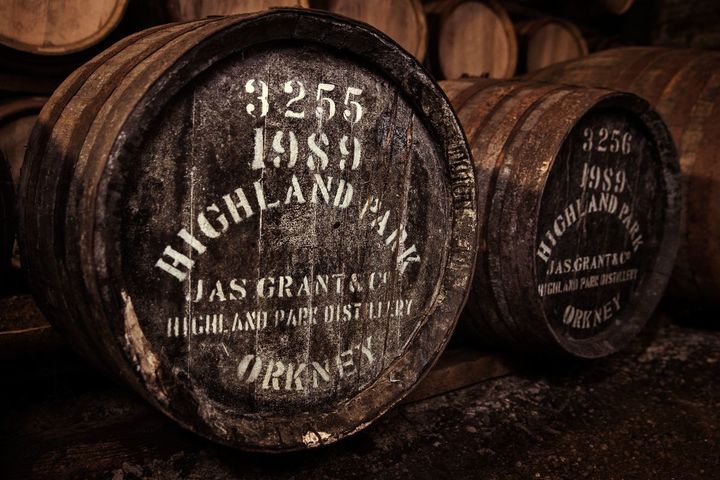
Warehousing facilities at the Highland Park distillery
Moreover, the industry’s explanation that it is just “renting the sherry” used to season barrels is a misnomer. Sherry that has been put into new barrels is far too tannic to be sold as sherry. Usually it is discarded or used in the production of paxarette or sherry vinegars.
The core range of Highland Park consists of a 12 YO, 18 YO, 21 YO, 25 YO, 30 YO, 40 YO and a 50 YO. In addition, there is a “Dark Origins” bottling that is a 12 YO that uses 80 percent first fill sherry butts. In addition, the distillery also offers the Valhalla range, a tribute to the islands’ Norse roots, which consists of a series of “Distillers Editions” named after the gods in Norse mythology (Odin, Thor, Loki and Freya), as well as the “Fire” and “Ice” bottlings also inspired by Norse mythology. The distillery also has a series of vintage bottlings (1964, 1968, 1970, 1971 and 1976) called the Orcadian series.
There have also been a variety of special bottlings, many of them exclusive to travel retail, commemorating the Battle of Jutland and Norse explorer Leif Erickson, as well as a Norse warrior series (Svein, Harald, Ingvar, Einar, Sigurd, Ragnavald, Thorfinn, and a 300-bottle limited edition King Christian I). These bottlings carry no age statement and seem to be differentiated by the more expensive bottlings having a higher proportion of sherry cask finished whisky in their blends. There is also a special Cappella expression that is only available at the distillery’s gift shop. Highland Park whisky is also an important component in the Famous Grouse whisky blend produced at the Glenturret distillery and in the Cutty Sark blend.
Different expressions in the Highland Park core range have varying ratios of sherry butt to bourbon barrel matured whiskies. The higher the age statement, and price, the greater the proportion of sherry matured whisky, especially the proportion of first fill casks, in the blend. The 12 YO, for example, consists of a blend of sherry butt and bourbon barrel matured whiskies, but only about 20 percent of the blend is first fill sherry casks. The 15 YO is a blend of 40 percent sherry butt and 60 percent bourbon barrel matured whiskies. Dark Origins, a NAS Scotch whisky, consists of 80 percent first fill sherry casks, 60 percent European oak and 20 percent American oak, and 20 percent refill sherry casks. The expression is a tribute to Magnus Eunson, the distillery’s founder, who at the time was described as a “dark distiller” and whose smuggling activities were called “dark duty.” The sleeve that the bottle comes in carries a stylized portrait of a mysterious looking individual, we do not have any idea, however, of what Magnus Eunson looked like.
The 18 YO, which has now become the brand’s flagship expression, is around 80 percent sherry butt matured whisky, of which 45 percent are first fill casks and the balance second fill, and 20 percent bourbon barrel matured whiskies. The 25 YO expression also consists of an 80-20 sherry and bourbon cask blend, but 50 percent of the mix is first fill sherry butts. The distillery “harmonizes” its casks by allowing the blended whisky to mature for an additional period of up to six months in barrels before being bottled.
Highland Park operates 23 warehouses at the distillery with a capacity of 45,000 barrels. About 80 percent of the distillery’s production is warehoused on the island, and the balance is warehoused at various warehouses on the mainland. Nineteen of the warehouses are dunnage type warehouses with dirt floors and casks stacked three high. The other four are racked warehouses where the barrels are stored on pallets.
Highland Park is among Scotland’s most outstanding whiskies, with an aroma and flavor profile that truly makes it unique among Scotland’s varied whisky offerings. Its superb craftsmanship, outstanding quality and storied history make it truly one of a kind, a shining star in Scotland’s whisky constellation.
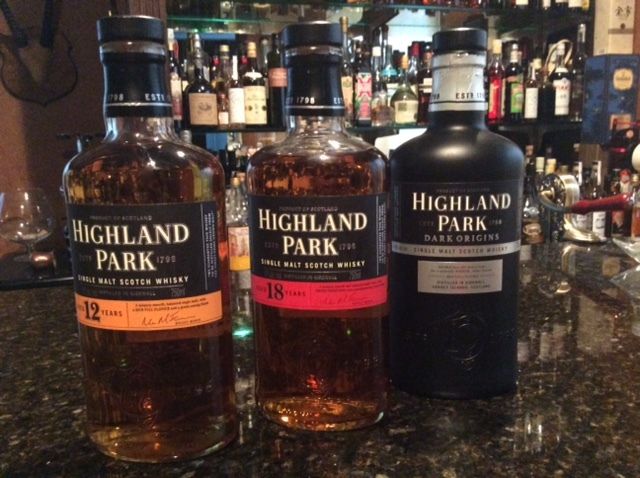
Three expressions of Highland Park’s Core Scotch Whisky Range
Tasting Notes
Per Highland Park, no caramel is added to any of their whiskies but they are chill-filtered, with the exception of Dark Origins, prior to bottling.
Highland Park 12 YO, 750ml, 43% ABV
The color is a light to medium amber color, what is sometimes described as burnished (or dark) gold. On the nose there is an immediate, pronounced ripe green apple note that dissipates quickly. This is followed by aromas of sweet honey, lemons and hints of tropical fruit. There is a faint smoky note that hangs in the background accompanied by a slight briny element. On the palate, there is a creamy silky texture with noticeable mouth weight, there is a slight bitterness that contrasts nicely with the sweet notes, followed by lemon and slight grapefruit notes, pineapple and tropical fruit notes, especially with the addition of a little water. The smoke is noticeable throughout but subdued, like an old piece of burnt toast or a cold campfire. The finish is medium length, slightly smoky throughout with hints of citrus and dried fruit and a very slight bitter note.
This is an excellent introduction to the Highland Park range. The whisky is well made with no obvious faults, although it lacks the concentration and intensity of the older whiskies in the range.
Appearance 8/10, Nose 25/30, Palate 27/30, Finish 25/30. Final Score 86/100
Highland Park, Dark Origins, NAS, 750 ml, 46.8 ABV
The color is a rich dark amber or light mahogany. Unlike the other expressions in the core range, Dark Origins is packaged in a very upscale looking black matte bottle. On the nose the sherry influence is unmistakable. There are noticeable dried fruit notes, followed by walnuts and almonds, and dried orange peel. There are hints of smoke, more subdued here by the influence of the sherry cask aging, along with that slight saline hint that is characteristic of Highland Park. On the palate, there is the creaminess and oily, heavy mouth weight typically associated with sherry butt matured whiskies. The alcohol “burn” is noticeable but not uncomfortable. This is after all a youngish whisky. The distillery doesn’t disclose the age of the blend, but I would guess the average age is probably between five to seven years.
There are the expected dried fruit notes of fig, and prune, and an ever so slight yellow raisin note along with hints of milk chocolate and a bit of caramel. Here too there are tropical fruit notes that become more pronounced with the addition of a little water, followed by elements of black pepper and hints of wood derived spices. There is a characteristic creaminess that hangs in the background, along with a pleasant cold smoke note. The finish is long, featuring chocolate and dried fruit notes that gradually give way to slightly spicy, peaty cold smoke.
Dark Origins is an excellent whisky in every respect, but it clearly shows it is still a teenager. While the sherry influence is unmistakable, the corresponding wood influences are still subtle, poorly defined and underdeveloped. Another five to ten years of sherry butt maturation would have produced a truly outstanding whisky, with the nuance and complexity that would have made it one of the top expressions in Highland Park’s roster. Perhaps there are such barrels of Dark Origins still slumbering in Highland Park’s warehouses. If so, the distillery isn’t saying.
Appearance 9/10, Nose 28/30, Palate 26/30, Finish 26/30. Final score 89/100
Highland Park, 18 YO, 750 ml, 43% ABV
The color is a mahogany. On the nose, there are pronounced floral notes, followed by honey and slight beeswax elements with dried fruit and very slights coffee notes. The peat smoke is subtler here and is accompanied by slight green, mossy and brushy notes. On the palate, there is a distinctive sweet, oily creaminess, followed by citric, and stone fruit notes, as well as dried fruit and some slight cereal/biscuit elements. There is a noticeable bitter note with elements of black pepper, cinnamon and perhaps a little nutmeg. The finish is long featuring dried fruit notes with a distinctive oily creaminess, followed by peppery bitter flavors wrapped in cold slightly peaty smoke.
This is a superb whisky. Long time aficionados of Highland Park, among which I include myself, will argue that the 18 YO is comparable to the 12 YO of 30 years ago. There is some truth to that claim. Certainly, the proportion of sherry cask matured whisky in the 12 YO is far less today than it was then. In fact, the proportion of sherry cask finished whisky in today’s 18 YO expression is roughly comparable to what used to be incorporated in the 12 YO of a generation ago, even though the 18 YO obviously is matured longer.
Edrington Group, one of the owners of Highland Park, has shown itself to be a master at the art of premiumization; steadily driving up the price of Highland Park’s range as well as revising blends, especially the entry level ones, to lower the cost of production. Clearly, it costs more to produce whisky today than it did a generation ago, this is especially true of sherry cask matured whisky that has been subject to increasing demand at a time that the underlying sherry industry and its supply of appropriate casks have been diminishing. As a commercial enterprise, it’s understandable that Highland Park would seek to expand its margins and profitability. Carried too far, however, this strategy will prove to be counterproductive in the long-term.
Whisky demand is not inelastic. Eventually rising prices will reduce the customer base and even though rising revenues may offset a shrinking customer base, it does so by weakening the durability of the brand long term. Whisky has a pronounced generational cycle that has now been in evidence for the better part of a century and a half. The current whisky boom will eventually come to an end. Once that happens, brands with the broadest customer base will be in a better position to ride out the inevitable downturn. There are plenty of choices in the whisky universe, even the most committed Highland Park fan will not be oblivious to the quality/price relationship.
Appearance: 9/10, Nose 28/30, Palate 28/30, Finish 27/30 Final Score: 92/100
Highland Park 25 YO, 750 ml, 48.1% ABV
The color is a rich mahogany. On the nose, there is a waxy note reminiscent of beeswax or furniture wax and a hint of new saddle leather, followed by aromas of orange zest, tropical fruits, dried fruit, especially stone fruit, and some slight caramel and chocolate notes. The smoke and peat are very subdued here. Highland Park’s new make spirit enters the cask at probably six to eight ppm phenol and after 25 years that has probably dropped to between three and five ppm, still discernable but part of a nuanced background rather than a distinct aroma element. The characteristic slight briny note of Highland Park is also evident.
On the palate, there is a powerful, concentrated heavy, oily mouthfeel. There is a distinctive sweetness that combines with the dried fruit to give it a more candied flavor. You can discern some orange zest, stone fruit like peach and apricot and tropical fruits like candied pineapple. There is a noticeable butterscotch note and a ginger pepperiness followed by wood spice notes, especially some cinnamon. There is also a croissant like buttery note, which comes across as creaminess and cooked cereal flavors.
The finish is long and complex, with honey and bees wax notes followed by flavors of sweet dried fruit, and hints of marmalade and marzipan. There are wood spice notes throughout, especially some cinnamon on the finish.
This is a superb whisky. Although at a retail price of around $600 US, it is now almost triple the price it was a decade ago.
Appearance 9/10, Nose 28/30, Palate 29/30, Finish 28/30. Final Score: 94/100
